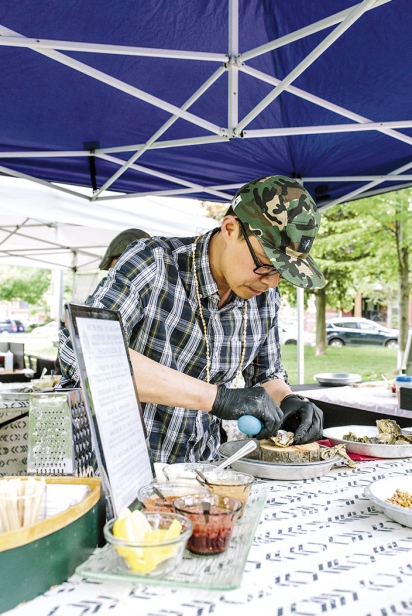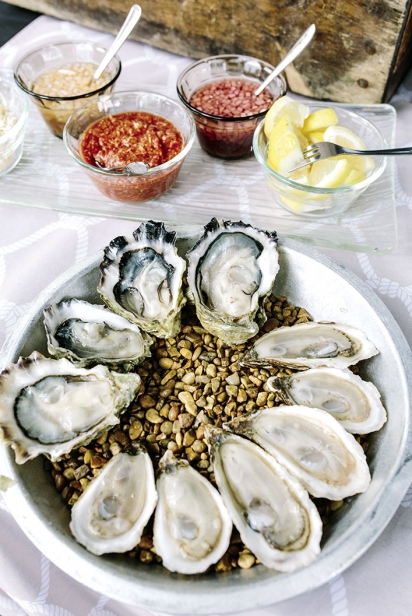Raw Talent
When Jason Kun takes a trip home to Prince Edward Island, he makes time for the oyster farms. Kun’s company, Island Oysters, sources oysters from the East and West Coasts for his kiosk at farmers’ markets and pop- ups across Toronto. There’s a curatorial flair to Kun’s service; he helps customers identify subtle flavour profiles and recommends garnishes and pairings. It’s akin to tasting fine wines with a knowledgeable sommelier.
“When I visit an oyster farm, what I like to do is look at a map to find out where the freshwater source is, I’ll even take a walk along one of the rivers that feeds the cove,” Kun says.
Each cove has a unique ecosystem and we learn its story every time we gulp down an oyster. Is it buttery? What’s the minerality like? How briny is it? What’s the texture? These tasting notes carry a whole landscape with them, according to Kun.
As an example of what he means, Kun mentions his visit to Cascumpec Bay, an oyster operation on PEI. “Peat bogs from surrounding estuaries give the oyster shells a dark cocoa colour. The nutrient-rich rivers flowing into the shallow Cascumpec Bay support a biodiverse ecosystem of trout, small fish, eels and shellfish, which I believe imbue a distinct buttery scallop note.”
Having first-hand knowledge of the oyster farms means Kun brings the ocean right to his customers in the heart of Toronto. “The ocean is one of the most powerful forces of nature in the world,” Kun says.
Rather than being tied down by a bricks-and-mortar location, Kun keeps Island Oysters nimble. He works with farmers’ markets and local breweries to create pop-up oyster bars and also caters.
Many customers first come across Kun at popular downtown farmers’ markets, including Trinity Bellwoods and Dufferin Grove. With an armful of local produce, market-goers line up for a quick oyster snack at Kun's booth.
Beyond his friendly approach, there’s something about the quality of Kun's oysters that gets people to queue. “A lot of people say, oh man, you guys have the best oysters. It’s kind of misleading because the oysters all come from the same place, they are the same oyster,” Kun says.
So if all St. Simon oysters come from the same farm in New Brunswick, why would they be any different at Island Oysters than they are at a bar that does buck-a-shuck?
The difference is partly in the ordering process, Kun says. While restaurants have to order a bulk amount for the weeks ahead, Kun puts in an order just days before each pop-up. “Essentially each individual oyster a person eats is ordered for them.”
In restaurants, a live oyster can sit in the fridge for up to three weeks, but Kun’s ordering strategy means Island Oysters' fare is always as fresh as can be. He keeps quality in check until the moment it enters a customer’s mouth — since he washes, stores, shucks and serves each oyster himself.
Kun is quick to point out that he has no problem with restaurants serving bivalves; they can be quite enjoyable, if the mollusks are treated well. Where he gets weary is when a single oyster travels between many hands during its journey from the farm to your plate. “There are so many steps involved in a large oyster house,” Kun says. “The oyster is ordered by someone, washed by someone different, shucked by someone different and then served by someone different. Not to knock on servers, but they don’t always know which oyster is which by the time the oyster gets to the table,” he notes.
There’s also the matter of buck-a-shuck to consider. The popularity of oysters is on the rise, as evidenced by Statistics Canada data that shows growth in production amounts and the value of those goods. At street level, one can see the increase in demand for oysters on restaurant menus and in daily oyster specials. According to Kun, the wholesale price of oysters has actually gone down. “The wholesalers are pushing the farmers down for the pricing because of buck-a-shuck … pushing for them to produce smaller, younger oysters,” he explains.
Kun sees both sides of the buck. “Buck-a-shuck is helpful in that it opens up more people to oysters, but it’s also harmful that people think that’s what oysters should be,” Kun believes.
And Kun should know — as he sees it, seafood is in his DNA. He grew up in the restaurant business. In the '80s, when he was in elementary school, he would help his parents out at their Chinese restaurant in Charlottetown, washing dishes and making eggrolls. The restaurant, located below the Kuns' apartment, was a popular post-bar hangout in Charlottetown.
“By the time I was in high school, I was working Friday and Saturday nights until like four or five in the morning. And coming home, my shirt would just smell like cigarettes and fryer grease,” Kun laughs.
But when the family wasn’t hard at work in the restaurant, they’d make their way to the beach to forage clams, quahogs, oysters and mussels. “We spent a tonne of time on these tidal pools, collecting clams and fishing for perch. That was my big memory as a kid,” Kun says. His father grew up in rural Guangdong province in China’s south, near a river. “When I was young my dad told me stories about him fishing at night, bringing it to market and making money,” he recalls.
So what’s it like for Kun now, who lives in Toronto, far from the ocean? He argues there’s no better hub for shellfish than Toronto. “Being so close to the middle of North America, we have access... [to] the East Coast and the West Coast. We have a tonne of volume and we have a tonne of talented chefs. It’s essentially one of the best places to eat oysters in North America.”
Island Oysters
islandoysters.ca | 416.899.8357 | @islandoysters






